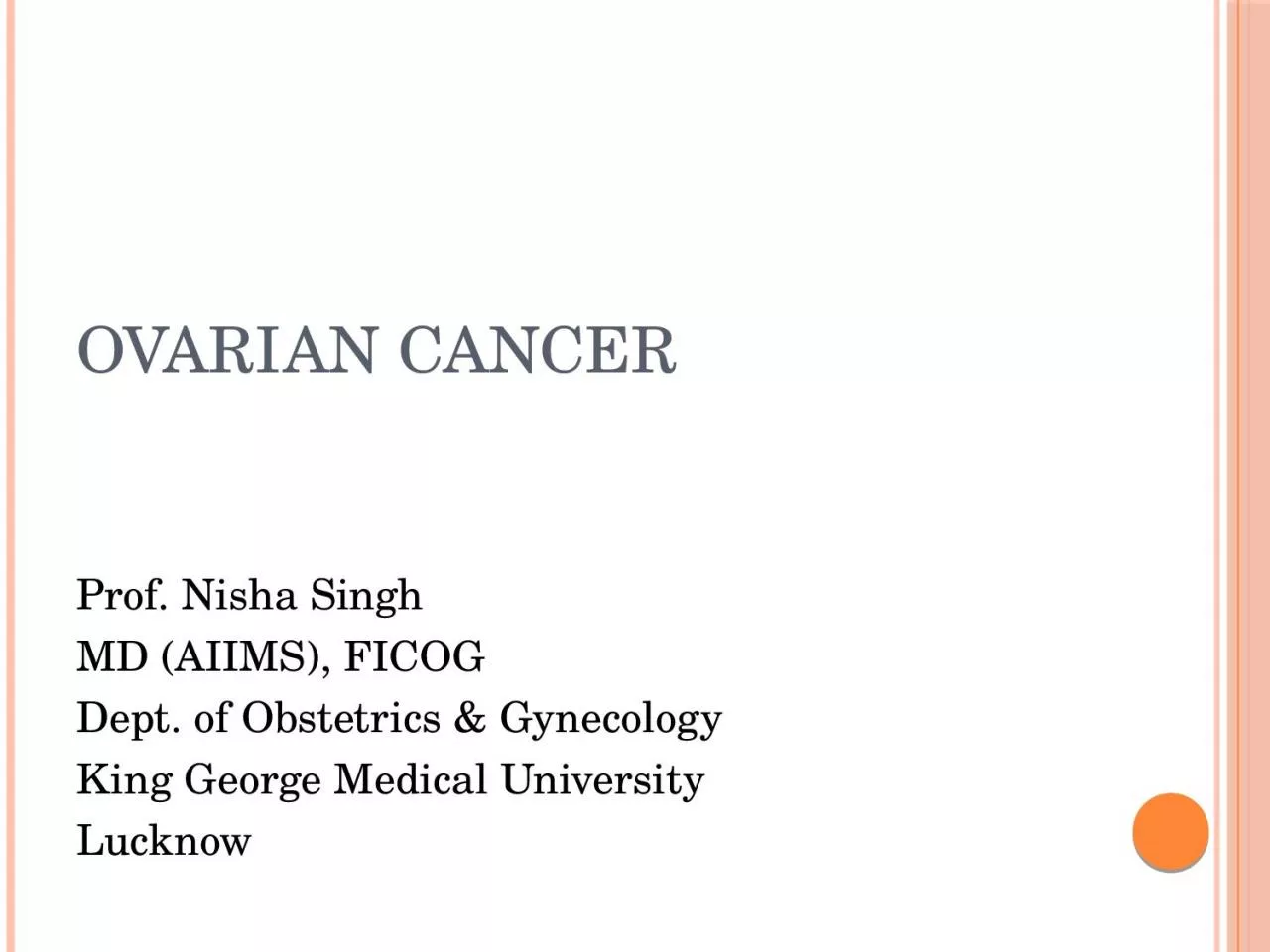

Singh MD AIIMS FICOG Dept of Obstetrics amp Gynecology King George Medical University Lucknow INTRODUCTION Fourth most common cause of death in women 30 of genital malignancies in the developed countries ID: 1041340
Download Presentation The PPT/PDF document "Ovarian cancer Prof. Nisha" is the property of its rightful owner. Permission is granted to download and print the materials on this web site for personal, non-commercial use only, and to display it on your personal computer provided you do not modify the materials and that you retain all copyright notices contained in the materials. By downloading content from our website, you accept the terms of this agreement.
1. Ovarian cancerProf. Nisha SinghMD (AIIMS), FICOGDept. of Obstetrics & GynecologyKing George Medical UniversityLucknow
2. INTRODUCTIONFourth most common cause of death in women30% of genital malignancies in the developed countries 5% of all gynecological cancers in India.Lifetime risk of having ovarian cancer 1.7% Majority (70%) of cases are diagnosed in advanced stage .
3. histological classification of ovarian tumors
4. EPITHELIAL CANCERMost common ovarian cancer- 90% .80% are primary in ovary 20% -metastatic from breast ,GIT , and colonMean age at diagnosis - 60 years. Effect of menopausal status In menopausal women- 30% of ovarian neoplasm are malignant In premenopausal women- 7% are malignant.
5. ETIOLOGYVarious theories Etiology not well knownHereditary or familial ovarian cancerBRCA 1&2 mutationsRas oncogenes, p53 mutations
6. RISK ModifiersNulliparityInfertilityEarly menarcheLate menopauseEndometriosisFamily historyTalc useProlonged use of ovulation inducing drugsHRTOral contraceptivePregnancyBreast feedingTubal –ligationHysterectomyProphylactic salpingo-oophorectomy.Risk factorsProtective factors
7. WHO CLASSIFICATION OF EPITHELIAL TUMOURS (2003)Serous adenocarcinomaMucinous tumours Adenocarcinoma Pseudamyxoma peritoneiEndometroid tumours Adenocarcinoma Mixed mullerian tumourClear cell adenocarcinomaTransitional cell tumours Brenner tumour Transitional cell carcinomaRare tumours Mixed carcinoma Squamous cell carcinoma Undifferentiated Small cell carcinoma
8. PATHOLOGY
9. Histological features and frequency of Epithelial tumorsCellular typeOther featuresFrequencySerousFallopian tubePsammoma bodies80%MucinousEndocervicalMucin-secreting cells10%EndometroidEndometrialMajority well differentiated10%Clear cellMullerianClear and hobnail cell<1 %Transitional cellTransitional cellDense, abundant fibrous stroma<1%
10. Distinct clinical behavior Irrespective of histologyLow grade tumors- usually serous or mucinous, asstd pseudomyxoma peritonei, responsive to CT, B raf and K raf mutations, longer progression free survivalHigh grade (Invasive cancer)- invasive(G2&3), p53 mutations, Poor prognosisBorderline tumors —15%, more in premenopausal, only 20% of these are metastatic
11. Ovarian cancer screeningMethodsAnnual pelvic examinationPelvic ultrasoundCA 125 Serum proteomic screening.Multimodal screeningNone is reliable and cost effective in general populationIndicated in familial ovarian cancers only BRCA1 & 2 gene mutations- if positive (82% risk) screen from 35yrs or prophylactic OCP or RR salpingooophorectomy
12. CLINICAL FEATURESAsymptomaticAnorexia, wt lossAbdominal –pain/ distension/bloatingIrregular massDyspnoeaNausea/constipationUrinary frequencyAscitesLower abdominal/ pelvic massOmental cakeNodules in pouch of douglasRectal examinationSymptomsSign
13. diagnostic criteria of ovarian cancer Ultrasonography Ovarian volume>10cm3Solid/complex(solid and cystic)MultiloculatedThickness of cyst wall>3mmSeptal thickness>2mmBilateralityPapillary excrescencesDoppler flow studiesIncrease in vascularityRI<0.04 PI<1CA-125HE 4, S. Inhibin
14. Other diagnostic methodsCT scan -Detects disease 1.5-2 cmMRI - Detects disease >1cmPET Scan- for distant diseaseConfirmed by Cytology or tissue diagnosisParacentesisFNACSurgical specimen
15. ASSESSING RISK OF MALIGNANCY IN OVARIAN TUMOURMorphological indexRisk of malignancy indexSerum biomarker levelsColour flow dopplerSerum proteomics.
16. RCOG guidelines RMI=U X M X CA125 USG score(0, 1,3) Multilocular cyst, solid areas, metastasis, ascites, bilateral lesions M score (premenop=1, postmenop=3)RMI <25-low risk, 25-250-mod risk, >250-high riskRMI (risk of malignancy index)
17. FIGO STAGING OF OVARIAN CANCER 1st Jan 2014Stage IGrowth limited to the ovariesIAGrowth limited to one ovary, No tumor on surface, negative washingsIBGrowth in both ovaries else same as IA,ICTumor limited to one or both ovariesIC1Surgical spillIC2Tumor rupture before surgery or tumor on surfaceIC3Malignant cells in ascites or peritoneal washings
18. Stage II Growth involving one or both ovaries with pelvic extensionIIAExtension and/or metastases to the uterus and/ or fallopian tubesIIBExtension to other pelvic tissues- bladder , rectum, sigmoid colon
19. Stage III APositive retroperitoneal lymph nodes and/or microscopic metastasis beyond pelvisIIIA1i--- metastasis<10mmii—metastasis> 10mmIIIA2Microscopic extrapelvic peritoneal involvement with or without RP LN IIIBMacroscopic extrapelvic peritoneal metastasis, none exceeding 2 cm in diameter with or without RPLN Includes capsule of liver or spleenIIICMacroscopic, extrapelvic, peritoneal implant >2 cm with or without positive retroperitoneal nodes.Stage IV APleural effusion with positive cytology.IV BHepatic and/or splenic parenchymal metastasisMetastasis to extra abdominal organs (inguinal nodes)
20. MANAGEMENTEarly ovarian cancer (Stage I and II) Surgical staging and debulkingAscitic fluid cytology or peritoneal washingsTotal abdominal hysterectomyBilateral salpingo-oophorectomyOmentectomyPelvic and para-aortic lymphadenectomyMultiple peritoneal biopsies
21. Adjuvant therapyEarly stage diseaseStage IA G1/2 (low risk) No adjuvant therapyStage IA G3, IB-II (high risk) 3 cycles of chemotherapyAdvanced stage diseaseStage III & IV 3-6 cycles of chemotherapyCarboplatin and Paclitaxel- Standard combination
22. Management of advanced-stage epithelial ovarian cancerStaging laparotomy and primary cytoreductive surgery followed by Postoperative adjuvant chemotherapy.Best results with Nil residual disease Debulk to microscopic level For inoperable tumors or high surgical risk cases Neoadjuvant Chemotherapy (NACT) followed by surgery and post operative chemotherapy .
23. Subsequent managementComplete response Follow-upPartial response Continue same chemotherapy or switch to second line chemotherapyStable disease switch to second line chemotherapyProgression of d/s switch to second line chemotherapy
24. Second line chemotherapy and other modalitiesDocetaxelTopotecanDoxorubcinGemcitabineEtoposideIfosfamideTamoxifenImmunotherapyHormone therapyGene therapyRadiation therapyHigh dose chemotherapy and autologus bone marrow transplantation
25. Follow up 3 monthly for 2yrs4-6monthly for 3-5 yrsAnnually after 5 yrsMethods– clinical, CA 125 (optional)CA 125 and CT for suspected recurrence
26. Q1 Which is the most common type of ovarian cancer?EpithelialGerm cellSex cord stromalUndifferentiated
27. Q2 All are risk factors for ovarian cancer EXCEPTNulliparityEarly menarcheEndometriosisTubal ligation
28. Q3Screening for ovarian cancer is recommended forWomen above 40 yearsWomen above 60 yearsAll womenWomen at high risk for familial ovarian cancer
29. Q4 FIGO stage III of ovarian cancer includesTumor limited to one ovaryTumor involving both ovariesTumor extending to pelvic organsTumor extending to abdominal cavity
30. Q5 Ovarian cancer is primarily managed by ChemotherapyRadiotherapyImmunotherapyStaging Laparotomy
31. What is the position of prevalence of ovarian cancer among genital cancers1234
32. Which other cancer is Associated with hereditory ovarian cancerGBLungBreastcervix
33. Borderline ovarian tumors are also known asTumors of low malignant potentialTumors of high malignant potentialHereditory ovarian tumorsSeccondary ovarian tumors
34. Spread to RP LN is seen in Stage1&2Stage 2&3Stage3&4Stage4 only
35. 5yr survival rate of StageI ovarian CA is30%50%70%90%